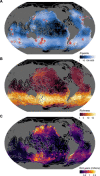Global political responsibility for the conservation of albatrosses and large petrels
- PMID: 33658194
- PMCID: PMC7929510
- DOI: 10.1126/sciadv.abd7225
Global political responsibility for the conservation of albatrosses and large petrels
Abstract
Migratory marine species cross political borders and enter the high seas, where the lack of an effective global management framework for biodiversity leaves them vulnerable to threats. Here, we combine 10,108 tracks from 5775 individual birds at 87 sites with data on breeding population sizes to estimate the relative year-round importance of national jurisdictions and high seas areas for 39 species of albatrosses and large petrels. Populations from every country made extensive use of the high seas, indicating the stake each country has in the management of biodiversity in international waters. We quantified the links among national populations of these threatened seabirds and the regional fisheries management organizations (RFMOs) which regulate fishing in the high seas. This work makes explicit the relative responsibilities that each country and RFMO has for the management of shared biodiversity, providing invaluable information for the conservation and management of migratory species in the marine realm.
Copyright © 2021 The Authors, some rights reserved; exclusive licensee American Association for the Advancement of Science. No claim to original U.S. Government Works. Distributed under a Creative Commons Attribution License 4.0 (CC BY).
Figures



References
-
- Albouy C., Archambault P., Appeltans W., Araújo M. B., Beauchesne D., Cazelles K., Cirtwill A. R., Fortin M.-J., Galiana N., Leroux S. J., Pellissier L., Poisot T., Stouffer D. B., Wood S. A., Gravel D., The marine fish food web is globally connected. Nat. Ecol. Evol. 3, 1153–1161 (2019). - PubMed
-
- Dunn D. C., Harrison A.-L., Curtice C., DeLand S., Donnelly B., Fujioka E., Heywood E., Kot C. Y., Poulin S., Whitten M., Åkesson S., Alberini A., Appeltans W., Arcos J. M., Bailey H., Ballance L. T., Block B., Blondin H., Boustany A. M., Brenner J., Catry P., Cejudo D., Cleary J., Corkeron P., Costa D. P., Coyne M., Crespo G. O., Davies T. E., Dias M. P., Douvere F., Ferretti F., Formia A., Freestone D., Friedlaender A. S., Frisch-Nwakanma H., Froján C. B., Gjerde K. M., Glowka L., Godley B. J., Gonzalez-Solis J., Granadeiro J. P., Gunn V., Hashimoto Y., Hawkes L. M., Hays G. C., Hazin C., Jimenez J., Johnson D. E., Luschi P., Maxwell S. M., McClellan C., Modest M., Notarbartolo di Sciara G., Palacio A. H., Palacios D. M., Pauly A., Rayner M., Rees A. F., Salazar E. R., Secor D., Sequeira A. M. M., Spalding M., Spina F., Van Parijs S., Wallace B., Varo-Cruz N., Virtue M., Weimerskirch H., Wilson L., Woodward B., Halpin P. N., The importance of migratory connectivity for global ocean policy. Proc. R. Soc. B 286, 20191472 (2019). - PMC - PubMed
-
- Block B. A., Jonsen I. D., Jorgensen S. J., Winship A. J., Shaffer S. A., Bograd S. J., Hazen E. L., Foley D. G., Breed G. A., Harrison A.-L., Ganong J. E., Swithenbank A., Castleton M., Dewar H., Mate B. R., Shillinger G. L., Schaefer K. M., Benson S. R., Weise M. J., Henry R. W., Costa D. P., Tracking apex marine predator movements in a dynamic ocean. Nature 475, 86–90 (2011). - PubMed
-
- Ramesh N., Rising J. A., Oremus K. L., The small world of global marine fisheries: The cross-boundary consequences of larval dispersal. Science 364, 1192–1196 (2019). - PubMed
Publication types
Grants and funding
LinkOut - more resources
Full Text Sources
Other Literature Sources

